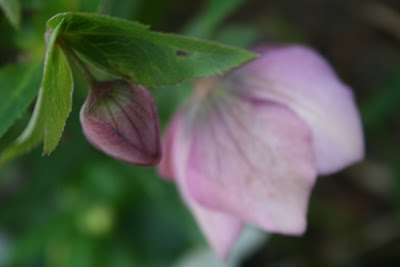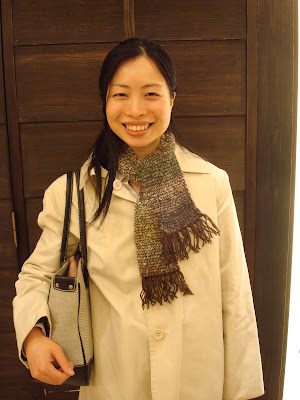So here is scarf #1 - my first time using circular needles (I'm hooked! er... needled? er... anyways...) I like circular needles because I can tuck my elbows in and knit while seated on a packed Japanese train.
Anyways, scarf #1... I took this one outside for a photo shoot, and managed not to get too many strange looks as I draped a scarf all over the neighbourhood greenery.


There were likely more than a few confused locals wondering when I suddenly made an abrupt turn, approached a flowering plum tree, threw a scarf into its branches and then began taking pictures, but I couldn't resist.

It will be warming the neck of a really sweet older gentleman who works at the museum. He seemed quite chuffed when I gave him the scarf, the ladies he works with at reception complained he was laughing and grinning too much.

He regularly gives the recipient of the pink scarf a brain teaser for "homework." A few weeks back, I listened as he was explaining the puzzle for the day. I didn't think I understood the puzzle, so asked a question about the way he had written it down. Turns out I understood it after all, as he smacked his forehead and pink scarf let out a noise of delight and understanding. My question, it turns out, made the solution obvious (although I still don't understand why!). The following week I was also given homework - serves me right! I was asked to come up with a list of 3 palindromes, sentences or phrases that are the same forwards and backwards. I'm allowed to come up with them in English, but I don't want to cheat by looking online, so far I only have his example "Madam, I'm Adam."
And scarf #2 - yes, I realize it looks almost the same as scarf #1. But it isn't. I insist!!



This scarf is going to a good friend who doesn't appear to own winter gear because he insists he doesn't get cold.

He likes to make fun of me for saying "Brrrrr!" when I am cold. Apparently this is not something he believes people actually say. He is adamant that he never heard it uttered in the nearly a decade he spent in the eastern US. When I put the question to a friend and my cousin (neither of whom had been coached), they both said that while it wasn't something they said, it was used. My friend finally admitted that maybe it was something that us weird Canadians said, what with our cold weather and general strangeness. I'm not sure I can claim that as a victory...
I also have two more colourful projects nearing completion, I had to start a more portable scarf when the shawl I'm knitting became too big to carry about and knit on the train. I'm also still working on the cotton cable scarf on itty bitty needles (it is very slow going and I get discouraged and bored and move on). Even more exciting is a wrapped parcel sitting beside my desk right now, that I am told contains yarn - a birthday gift! Not knowing what the yarn looks like is just about driving me bonkers, so it may not make it all the way to my birthday...

























